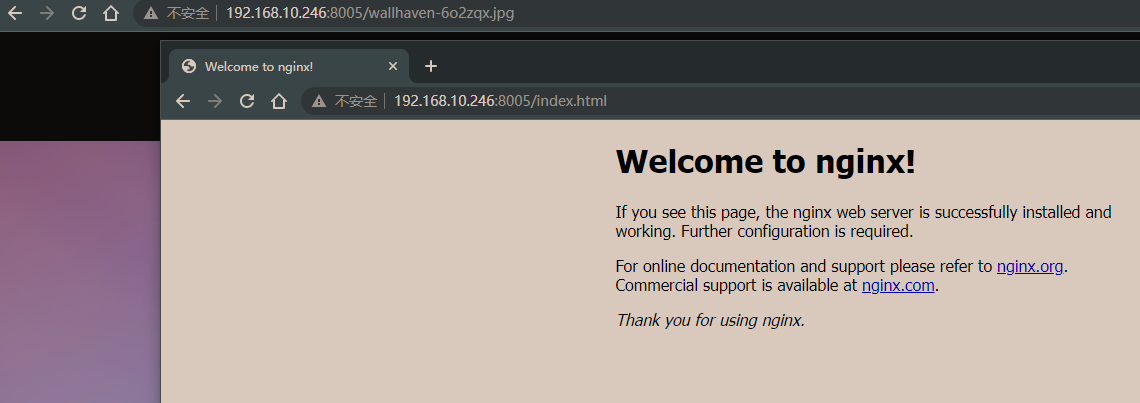前言
最近接了个小需求,将服务和前端资源实现分离,很早之前就使用过 nginx 做动静分离,不同的是,这一次使用的是在 docker 环境下,配置方面没有多大区别,主要是启动 nginx 和 nginx 的挂载目录需要注意下,下面就开始吧!
动静分离
动静分离简单来说就是把动态跟静态请求分开,不能理解成只是单纯的把动态页面和 静态页面物理分离。严格意义上说应该是动态请求跟静态请求分开,可以理解成使用 Nginx 处理静态页面,Tomcat 处理动态页面。动静分离从目前实现角度来讲大致分为两种:
- 第一种:是纯粹把静态文件独立成单独的域名,放在独立的服务器上,也是目前主流推崇的方案;
- 第二种:方法就是动态跟静态文件混合在一起发布,通过
nginx来分开。
以上内容搬的以前 nginx 的文章,感兴趣的小伙伴可以去看下这篇笔记动静分离简介

通过 location指定不同的后缀名实现不同的请求转发。通过 expires参数设置,可以使浏 览器缓存过期时间,减少与服务器之前的请求和流量。具体 Expires定义:是给一个资源 设定一个过期时间,也就是说无需去服务端验证,直接通过浏览器自身确认是否过期即可, 所以不会产生额外的流量。此种方法非常适合不经常变动的资源。(如果经常更新的文件, 不建议使用 Expires 来缓存),我这里设置3d,表示在这 3 天之内访问这个URL,发送一 个请求,比对服务器该文件最后更新时间没有变化,则不会从服务器抓取,返回状态码304, 如果有修改,则直接从服务器重新下载,返回状态码 200。
准备环境
- 保证系统有
Docker 环境,有无网络均可。
- 有网络的情况下使用
docker pull拉取镜像,无网络的情况下使用docker load < [images_name]导入镜像
# 搜索镜像
$ docker search nginx
# 拉取镜像
$ docker pull nginx|latest
# 创建工作目录
$ mkdir -p /nginx/{conf,conf.d,logs,data}
# 在data目录下添加html文件夹和image文件夹
$ docker run -dit nginx
# conf 里放 nginx.conf 配置文件, 这个文件的内容要从镜像里的复制出来,前面是容器的路径 后面是宿主机的路径
$ docker cp 容器id:/etc/nginx/conf.d/default.conf /nginx/conf.d/default.conf
$ docker cp 容器id:/etc/nginx/nginx.conf /nginx/conf/nginx.conf
# 删除容器
$ docker rm $(docker stop 容器id)
# 查看nginx启动日志
$ tail -f /nginx/logs/error.log
$ docker run -dit --restart=always --name=nginx -p 8005:80 -v /nginx/data/image:/data/image -v /nginx/data/html:/usr/share/nginx/html -v /nginx/conf/nginx.conf:/etc/nginx/nginx.conf -v /nginx/logs:/var/log/nginx -v /nginx/conf.d:/etc/nginx/conf.d nginx:latest
#######################################################
* --restart=always: 异常关闭后重新尝试启动
* -v /nginx/data/image:/data/image:挂载宿主机的image文件
* -v /nginx/data/html:/usr/share/nginx/html: 挂载宿主机的html文件
* -v /nginx/conf/nginx.conf:/etc/nginx/nginx.conf: nginx配置文件
* -v /nginx/logs:/var/log/nginx: 日志文件
* -v /nginx/conf.d:/etc/nginx/conf.d: 默认配置文件
- 配置动静分离,修改
/nginx/conf.d/default.conf配置文件
server {
# 监听端口
listen 80;
listen [::]:80;
# 对应域名,单个网站域名网站也可写localhost
server_name ip;
#access_log /var/log/nginx/host.access.log main;
# 可以配置多个location
# 配置html访问路径 https://ip:port/index.html
location / {
root /usr/share/nginx/html;
index index.html index.htm;
}
# 配置图片访问路径 https://ip:port/*.jpg
location ~ .*\.(gif|jpg|pdf|jpeg|png)$ {
expires 8h;
root /data/image/;
}
# 拦截后台请求,正则匹配 api 路径
location ~* ^/(code|auth|admin|gen|dcmp|transport) {
# 配置代理地址
proxy_pass http://ip:port;
#proxy_set_header Host $http_host;
proxy_connect_timeout 15s;
proxy_send_timeout 15s;
proxy_read_timeout 15s;
proxy_set_header X-Forwarded-Proto http;
proxy_set_header X-Real-IP $remote_addr;
proxy_set_header X-Forwarded-For $proxy_add_x_forwarded_for;
}
#error_page 404 /404.html;
# redirect server error pages to the static page /50x.html
error_page 500 502 503 504 /50x.html;
# proxy the PHP scripts to Apache listening on 127.0.0.1:80
#
#location ~ \.php$ {
# proxy_pass http://127.0.0.1;
#}
# pass the PHP scripts to FastCGI server listening on 127.0.0.1:9000
#
#location ~ \.php$ {
# root html;
# fastcgi_pass 127.0.0.1:9000;
# fastcgi_index index.php;
# fastcgi_param SCRIPT_FILENAME /scripts$fastcgi_script_name;
# include fastcgi_params;
#}
# deny access to .htaccess files, if Apache's document root
# concurs with nginx's one
#
#location ~ /\.ht {
# deny all;
#}
}

PS: 中间有一段踩坑经历:在备份 default.conf 的时候名字前缀不要为 default-*.conf,最好也不要放在同级目录下,不然会导致配置覆盖,无法生效,不注意就排查很久无法找到原因,同时修改配置后建议重启容器。docker restart [容器ID];
|  发表于 2021-12-28 17:53
发表于 2021-12-28 17:53
 发表于 2021-12-28 21:21
发表于 2021-12-28 21:21
 发表于 2021-12-28 21:57
发表于 2021-12-28 21:57
 |
发表于 2021-12-29 09:42
|
发表于 2021-12-29 09:42
 |
发表于 2021-12-29 09:49
|
发表于 2021-12-29 09:49